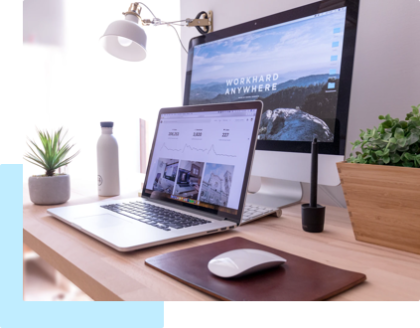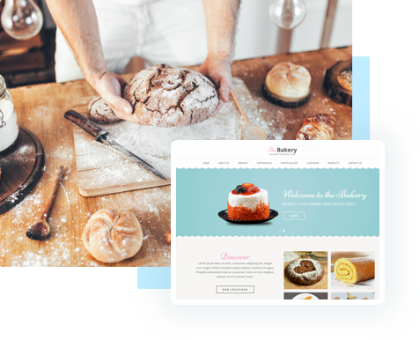How to Create a Website:
A Practical Guide to Your First Launch
With the right tools, approach and guidance, learning how to create a website from the ground up is easier than ever before. More importantly, it's necessary for the growth and success of your business long-term. Get started by following these essential first steps.
Choose a Website Builder
There are plenty of options to choose from when deciding what type of software or platform to use when you're learning how to create a website. Plug "website builder" into Google and you'll see what we mean.
As you vet what's out there, it's important to keep two things in mind: ease of use and flexibility. Not to mention the cost.
When you're new to website creation, it's tempting to go with the first thing that catches your eye. But challenge yourself to think in the long-term because you want to create more than just a website. You want to create an online presence and experience for your intended audience in a way that's scalable over time.

Identify Your Website Goals
You're creating a website for a reason. Maybe it's to sell something. Maybe it's to sell many things. Or maybe, what you're selling isn't a "thing" at all but an idea.
Ask yourself a few questions before you begin to create a website:
- Why do you want to build a website?
- What features will your website need to be successful?
- How will you define success relative to your website?
There's no right or wrong answer to these questions, as long as they're meaningful to you and actionable.
Bluehost customers, for example, have created websites for just about everything. From a dog training business to six-week blogging challenges, selling quirky home furnishings to rare book finds, you can bring just about any idea to life online.
Opt for Flexibility
While ease-of-use is important, flexibility is what really allows you to push the boundaries of what your website is capable of. The learning curve upfront is natural, especially when you're in the midst of learning how to create a website for the first time.
Don't let the fear of the unknown steer you away from a website builder that's customizable and adaptable to your needs as they evolve over time.
WordPress is an unbeatable option for creating a website. While the platform requires a little more familiarizing upfront than some other popular options, the advantage to having complete control over your website makes up for it. Plus, we've got a complete guide to getting started on WordPress that makes the start-up process that much simpler.
WordPress is often referred to as the world's most popular website building platform with over 35% of all websites on the internet powered by WordPress.
WordPress empowers you to create any type of website you could imagine — an eCommerce store powered by popular plugin WooCommerce, lifestyle blog, community forum, professional website and so much more.
The open-source nature of WordPress is also another point in its favor. With millions contributing globally to the building of themes, plugins and other add-ons, there's always new functionality to explore in making your website the best it can be.

Decide Where to Host Your Website
Before you can dig into the details of learning how to create a website for the first time, you'll need to choose where to host your website. And while there's no one-size-fits-all option for hosting, if you know what to look for, it's easier to land on a plan that's right for you.

What is Web Hosting?
Let's start with the basics. For those of you brand new to creating a website and all of the lingo that comes with it, let's cover how web hosting works.
Think about web hosting in terms of moving into a new house. When you move, you bring with you a number of belongings. And those belongings have to live somewhere — they need to be organized (whatever your definition of "organized" might be) in a centralized location for everyday use.
A web host, in this case, is your website's house. Your belongings are the files, image and HTML code you use to make it your home.
When using a platform like WordPress, You'll need to essentially rent a space for your website to reside. As a business, it's like renting a physical space on Main St. for your brick and mortar store to stand and attract potential customers.
Pick the Web Hosting Plan That's Right for You
When you're choosing a hosting plan that's right for you, there are a number of factors to be conscious of.
- How many websites do you want to create?
- What kind of files and creative will you be using on your website that might impact the amount of storage you'll need?
- Do you need a high level of customization, security and reliability?
The answers to these questions will help you determine what type of web hosting you'll need. For most business owners, shared web hosting is the way to go. It's more cost-efficient to share hosted space among several customers with security and maintenance updates managed by the hosting company.
With that being said, there are also options for dedicated and VPS as well that give you more control over your own designated space.
Additionally, if you've opted for building a website on WordPress, choose from shared WordPress hosting, WP Pro and WooCommerce hosting plans. Each one allows for easy auto-installs and configuration, in addition to automatic updates, a business email account through Microsoft 365 and more.

Register Your Domain
With the backend heavy lifting and decisions made, it's time to let the creative juices flow. This starts with the selection of a domain name.
If mention of the word domain has you drawing a big blank, let's break it down.

What is a Domain?
Remember the house analogy we made when talking about web hosting earlier? Well, a domain name is your website's address.
When you type an address in Google Maps, they come back with a little red location marker zoomed in from a much larger map. When someone types your domain name on the internet, it's converted into an IP address. Then, much like Google Maps, your hosting company surfaces all of the files associated with your website to the interested parties.
How to Choose a Domain Name
Domain names make it easy for online users to find you. Rather than type out the string of numbers and characters that make up your IP address, you give them something a little easier to remember. And, if you're approaching it from a branding perspective, something that's clearly associated with your business.
With the above in mind, keep it simple. Google, Facebook, Twitter, and Apple are more than just successful brands. They're successful domains. They're unique and easily recognizable, short and easy to pronounce.
When you're thinking about the value of word-of-mouth marketing, these considerations can go a long way.
A domain name will also require consideration relative to the extension. A domain extension is what follows the "dot" of your URL address. Beyond the common .com domain extension are options like .net or .info.
Search for your desired domain to see what's available, knowing that you can always expand your search by extension. At the end of the day, you want to land on something that's unique to your business and not totally out of left field usability-wise for your intended audience.
Why Would I Need More Than One Domain?
There may be times when you need to purchase more than one domain for your website. For example, if your domain contains a word that is commonly misspelled.
You want to maximize your website's potential for being found online. To do so, you can purchase a primary domain and variations of that domain. This will ensure you stay top-of-mind, even when searches don't always match up.
This may influence what type of web hosting plan to select — a basic option with one included domain. Or one that allows for unlimited domain claims.

Design Your Website (Even If You're Not a Designer)
Beyond the backend technicalities that come with learning how to create a website, many are intimidated by the design aspect. How do you design a website when you're not a designer by trade?
All we can say to that is thank goodness for the internet. Not to mention content management systems like WordPress that make web design more approachable.
You can think about web design in two ways: how it looks on the surface to your audience and how it functions.

Make your Website Attractive
What your website looks like at the surface-level will require some thought. And we won't make it out to be a complete walk in the park.
You're going to have to make some decisions relative to your brand and how you want it represented to those searching for it online.
You'll need to answer questions such as:
- What colors do you want to use?
- Do you have a logo?
- What kind of effects will help your pages stand out?
Invest in a Website Theme You Love
The good news about designing your website is that you don't need a designer to create something beautiful. WordPress users have created a number of theme designs that you can install on your website.
Think of themes as the "skin" of your website. It's what lays over top, attracting audiences and developing the feel of your brand.
Themes typically range in cost from $29 to $150, making them a cheaper alternative to the hourly rates charged by professional designers. They are also still customizable in terms of your preferred plugins (which extend functionality), navigation, and color palette.
Make your Website Functional
Your website looking good is one thing but above all else, you want it to keep people engaged. If someone can't find what they're looking for when they land on your website, it doesn't do your business much good in the long run.
Functionality is relative to whatever platform your audience is searching on. For example, one website design trend that isn't going anywhere soon is creating an experience that's mobile-friendly.
As of 2018, 52.2% of all website traffic worldwide was generated through mobile devices. You're missing out on a major chunk of potential viewers when neglecting designs that translate to a mobile screen.
Additionally, it's important to keep track of metrics relative to the traffic your website is driving. Reviewing this data is the only way you can improve upon your website's design and flow over time. Make sure to install Google Analytics (which is free) to ensure that you always have access to your most insightful website data.
Finally, if you're trying to optimize the experience for conversions, simplified navigation and clear messaging will be key.
Explore Available Plugins
WordPress plugins are add-on pieces of software you can install on your website to extend its functionality. This can include everything from s ecurity-based plugins like Wordfence to blogger favorites like Yoast for SEO.
If there's something you want your website to do, we can almost guarantee that there's a plugin that someone has already made to help make it possible. In fact, there are 55,000+ plugins to make it happen.

Fill in the Blanks With Content
The finishing content touches on learning how to create a website are perhaps some of the most important ones you'll make. What your audience sees and reads relative to your brand on its website will determine their actions.
Think of your homepage or whatever page a visitor happens to land on as the first impression. You have to provide what they're looking for, keep them interested, and ideally move them towards a desired action.

Be Conscious of Your CTAs
This desired action you want customers to take that lead to a conversion are also referred to as calls-to-action (CTAs). As you create the pages of your website, it might be helpful to start from the end-goal and work backward.
For example, if you want someone to buy a product, you're going to undoubtedly need a product page. But you might also want a page that describes how to use the product if it's not self-explanatory.
Think about the pain points your audiences might have and how you can solve them with your specific expertise. You may not know what these exact pain points are right off the bat but as your website garners more traffic, you'll have more data to pull and learn from.
Add a Blog
Blogs are fairly commonplace nowadays among personal and business-centric websites, alike. They make it easy to share ideas, develop a brand, and also drive traffic.
Like anything you incorporate when learning how to create a website, however, you'll want to make sure that your blog is optimized for performance. You can create a space filled with words and images but if it's not useful to your visitors or no one can find it, what's the point?
WordPress provides a number of plugins for bloggers that help users track metrics, manage comments, improve SEO, and everything in between.

Build an Email List
With your website live and driving traffic, you'll also be able to start making use of that traffic off of your website, as well. Doing this means that you can gather information about your visitors that'll help influence how you market to them.
One way to accomplish this is with an email list. Should you use a WordPress newsletter plugin? If you find one that suits your needs, then it definitely doesn't hurt.
These plugins can be used to manage content forms and subscriber lists. Some will even provide email marketing templates for use in your outreach strategy.
Even if you don't want to manage an email marketing program right away, you can always add in that functionality at a later date. The existence of these kinds of plugins are just one of the many reasons why WordPress makes it so easy to not just create a website but create one that works.
Highlight Testimonials and Reviews
You can rave about your brand all day long but what people really want to hear is what others have to say. And the proof is in the stats with 95% of shoppers reading online reviews before making a purchase.
As you build out the content for your website, try to consider all of the possible ways you can promote what you have to sell.
Even if, as a blogger, what you have to sell is your content, there are ways to incorporate feedback through forums and comments. Think beyond your Home, About, and Product pages to create an experience that's relevant and personal to your intended audience(s).
Get Visual
Content is more than words. It's the culmination of copy, imagery, video, and other media working together to tell your brand story.
Think about how you want to convey the different messages you have to display across your website. Whether you opt to for something like stock photography right out of the gate or decide to invest in more custom creative, the money saved from creating a website yourself is sure to come in handy.

Host it. Build it. Publish it.
Get StartedSpecial Intro Offer & 30-Day
Money-Back Guarantee
Intro Offer:
The promotional price is for the first term only and plans renew at the regular rate.
Money-Back Guarantee:
Your satisfaction is our top priority and we're confident you'll be pleased with our services. Still, if you try us and decide your account does not sufficiently meet your needs, you can cancel within 30 days for a refund as follows:
- If you cancel within 30 days you'll receive a full refund on your hosting service only. The money-back guarantee does not apply to most add-on products, such as domains, given the unique nature of their costs.
- If you cancel within 30 days and your plan includes a free domain, there will be a fee to retain that domain. Bluehost will deduct a non-refundable domain fee from your refund, at the regular cost of your domain.
- Bluehost does not offer any refunds for cancellations that occur after 30 days.
The browser version you are using is no longer supported. Please upgrade for the best site experience.
